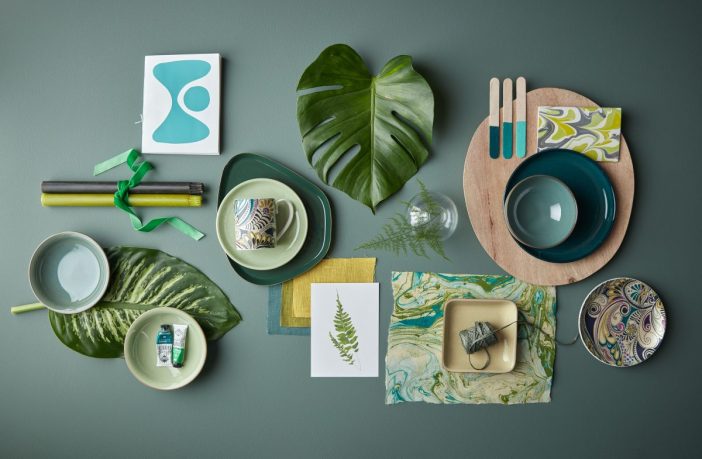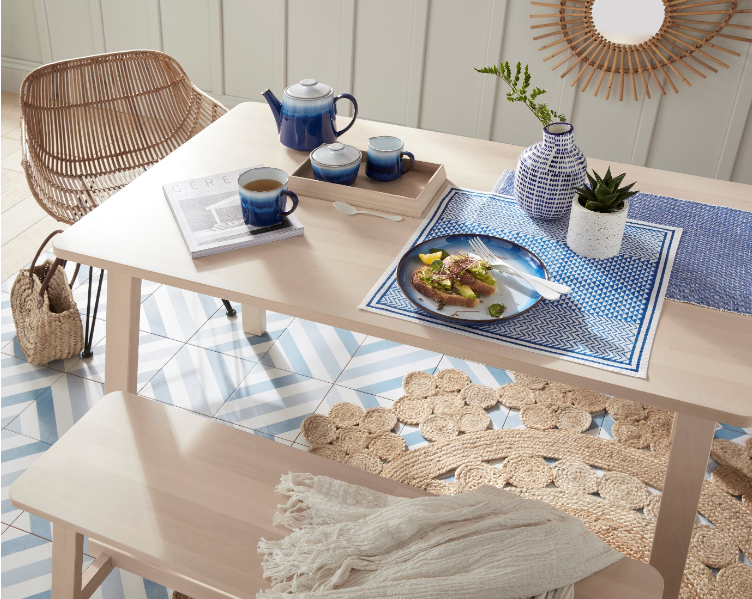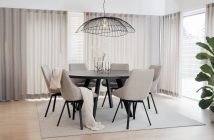Looking for some inspiration to evolve your interiors? Nicola Wilson, Pattern Design Manager at Denby, shares her top tips for releasing your inner interior designer by creating the mood board of all your decor dreams!
Redesigning any room in your home is an exciting time, but with so many varied trends and styles to explore it’s easy to be overwhelmed by choice.
One of the most efficient ways to collect your ideas and spark inspiration is to build your very own interior design mood board. A mood board is a space to assemble your ideas for your interiors and see them come together all in one place.
The board can be physical, which allows you to use a range of textures and swatches. Alternatively, you can make a digital version, Pinterest is the most popular platform for digital mood boards, as the website is completely free and allows you to browse other people’s boards for inspiration too.
As well as giving you the opportunity to have all your options in one place, mood boards also help you put different strands of ideas together and create a coherent look which suits your own taste. Plus, they’re really fun to make!
But how exactly do you go about making one?
Nicola shows us her tips and tricks on setting up your own interior design mood board and discover how to make it as effective and realistic as possible.
BROWSE FOR INSPIRATION
To get some inspiration for starting your mood board, why not give window shopping a go? As well as giving you some fun ideas to get started with, seeing the prices of your favourite pieces will also help you figure out what you can do with your budget. Plus, seeing the furniture in person may help you realise exactly what you’re looking for.
Many homeware stores set up displays of their products, which helps you see how each piece works with other colours, fabrics, and pieces of furniture in the store. If you plan to use this shopping trip to commit to your ideas, you can even consider buying something to add to the mood board straight away. It doesn’t have to be anything big — even something as small as a candle or a new set of dining plates can be a great place to start for a mood board, and it is bound to inspire you further.
EXPERIMENT WITH COLOUR
If you’re looking to do something a little different when it comes to remodelling, use your mood board as an opportunity to try out unique and unusual combinations. This is the experimental stage, so no idea is off the table. Play with a wide range of your favourite colours and patterns to see which combinations work well. You may even find that two shades you never expected to work together make the perfect pairing!
If you’re still stuck on finding your dream colour combination, turn to the colour wheel. Shades which are opposite each other on the colour wheel (known as complementary colours) work well together, as do shades next to each other, so bare this in mind when searching for your perfect combination.
Additionally, remember that there are a wide range of ways to incorporate colour, both big and small. For example, you could have a dark blue base colour for your kitchen and complement it with accents like light blue kitchen equipment and ceramics.
INCORPORATE WHAT YOU ALREADY HAVE
Rather than starting from scratch completely, use your mood board to find ways of using what you already have. As well as allowing you to stretch your budget further, this will help you reduce your impact on the environment too. By upcycling your old products rather than discarding them, you’re saving your old pieces from going to landfill.
The good news is that there are plenty of ways to transform old pieces and give them a new lease of life. Whether you want to paint your old dining table, overlay your kitchen countertops, or reupholster your dining chairs, doing this rather than buying new will allow you to save your budget for new pieces, whether they be large changes like new flooring or small but equally vital additions, like new tableware.
CONSIDER THE PRACTICALITIES
When it comes to crafting your mood board, there are no wrong answers or bad ideas, as this is a chance for you to experiment. However, to avoid any future disappointments, it’s important to consider the practicalities of your ideas. While you might fall in love with some designs, you may not have the budget or the space to make them happen, so try to be relatively realistic with your mood board.
Don’t let practicalities dampen your inspiration completely though, as you may be able to incorporate your ideas in some form. Try to consider what appeals about your grand idea, and think about ways which you can scale that back or adapt it to suit your requirements.
DON’T FORGET THE SMALL DETAILS
Many people use their mood boards to plan out the big changes, like new flooring, a different wallpaper, or key pieces of furniture like sofas or dining tables. But don’t forget to consider the small details too, as these are the things which will set your newly renovated room apart from the rest.
Adding the small details to your mood board, whether they’re new ceramics for the kitchen or cushions for the sofa, will help you create a coherent look. Plus, it will make the renovation process much easier when your mood board is planned to the last detail. So, take some time to browse your favourite homeware stores to find the inspiration you need, right down to the small finishing touches.
Using Nicola’s tips you can create a mood board tailor made for all your interior desires and fall in love with your home!




